Victoria Olt “Lost Gods”

“We are still at the mercy of fate, however we choose to define it. But the lessons from the past—what our ancestors believed about life, death, and human nature—remain deeply relevant, and there’s so much we can learn from them."
On January 4th Victoria Olt Gallery unveiled a new exhibition titled Lost Gods, where intricate watercolor techniques were seamlessly blended with the themes of ancient cultures. The highlight of the exhibition was a striking 20 m² installation of paper cranes, a reference to the Japanese legend that promises a wish, often for a long life, to anyone who folds 1,000 origami cranes.
Victoria Olt described the exhibition as a continuation of her ongoing search for meaning, explaining: “Lost Gods was another step in my journey to make sense of the world. After finding little comfort in modern popular religions, I looked to the past to see what wisdom could be gained from ancient civilizations. What I discovered is that many of the struggles our ancestors faced are remarkably similar to the challenges we continue to grapple with today. We are still at the mercy of fate, however we choose to define it. But the lessons from the past—what our ancestors believed about life, death, and human nature—remain deeply relevant, and there’s so much we can learn from them."
The exhibition explored a wide range of mythological figures and themes, starting with the most iconic characters from Greek mythology. Visitors were introduced to Aphrodite, the goddess of love and beauty, born from the foam of the sea, and her son Eros, whose notorious arrow, meant to strike Psyche at his mother’s command, ultimately backfired on him. The myths presented included tales of divine vengeance, destruction, human suffering, and remorse, but also preserved the belief that hope persists—like in the story of Pandora’s Box.
Nordic mythology was also prominently featured, with stories of the first humans, the Norns who governed time and fate, and Hel, the feared ruler of the underworld. The exhibition extended beyond European myths, incorporating mythical creatures from the indigenous peoples of North America, as well as tales from ancient Egypt and Mesopotamia, centered around themes of life, death, rebirth, love, and revenge.
More exotic myths brought a global richness to the exhibit, such as the Hawaiian fire goddess Pele and the Japanese sun goddess Amaterasu. Throughout the exhibition, many of the myths served as cautionary tales, their messages resonating as strongly today as they did in ancient times.
Lost Gods invited visitors to reflect on humanity’s timeless quest for understanding and meaning, and how the echoes of ancient wisdom still hold powerful relevance in our modern world.
2020
Handmade watercolor on paper.
12 x 16 in
31 x 41 cm + frame included for free in shipments within Estonia
} Amaterasu {
Is a Shintō deity, a celestial Sun Goddess. The Japanese royal family claim they are descendants from her. She was born from Izanagi's ("He who invites") left eye, who also set her to rule Takamagahara (the “High Celestial Plain”), where all the Gods lived.
At one time, her brother Susanowo played a cruel trick on her and she went into hiding in the cave of heaven and refused to come out. The world became dark, allowing evil spirits to roam across the land. All the Gods came together to try and lure Amaterasu out of the cave and they tried many different things but nothing worked. They then placed a great big mirror in front of the cave and started having a loud, jolly party. It was only when the Goddess of laughter began to dance did the Sun Goddess have a peek. Once she saw her own reflection in the mirror, she became so fascinated that she came out of the cave and covered the world in light once again.
2020
Handmade watercolor on paper.
15 x 22 in
38 x 56,5 cm + frame included for free in shipments within Estonia
} Osiris {
Was the God of fertility, agriculture, the afterlife, the dead and resurrection. He was the first God to die, when his brother Set tore him to pieces. However he was brought back to life by Isis (goddess of motherhood, magic, fertility, death, healing, and rebirth), who wrapped him in linen and breathed new life into him. Because of this he is also the first mummy. Osiris and Isis conceived Horus, after which Osiris returned to rule and act as judge in the Underworld. It was also believed that pharaoh became a manifestation of Osiris after death, while a living king was identified with Horus.
2020
Handmade watercolor on paper.
4.7 x 17.7 in
30,5 x 45 cm + frame included for free in shipments within Estonia
} Adonis {
Aphrodite cursed Myrrha to fall in love with her father, the king of Syria. Myrrha tricked her father to conceive Adonis and when his father found out, he tried to kill both himself and Myrrha. Myrrha pleaded with the Gods and in their mercy, Myrrha was turned into a Myrrh tree. In this tree-form she gave birth to Adonis.
Adonis possessed exceptional beauty, so much so that Aphrodite fell in love with him. She took him under her protection and tasked Persephone to raise him. As he grew more handsome, Persephone also fell in love with Adonis and refused to return him to Aphrodite. Zeus had to step in to settle the dispute and it was agreed that Adonis would spend 1/3 of the year with Aphrodite, another 1/3 with Persephone and the rest of the year he could spend with whomever he wished.
Ares became jealous over Aphrodite and sent a wild boar to kill Adonis. Adonis bled to death in Aphrodite’s arms and as she cried Anemone grew from her tears.
2020
Handmade watercolor on paper.
12 x 16 in
31 x 41 cm + frame included for free in shipments within Estonia
Medusa, one of the hideous Gorgon sisters, used to be a beautiful mortal priestess of Athena until she had an affair with Poseidon, God of sea, in Athena’s temple. This breaking of her vow of celibacy and desecrating the temple enraged Athena so that she turned Medusa into a hideous hag and her hair into snakes. So horrible was she, that anyone who looked upon her turned to stone. The hero Perseus was later sent to kill her. He fought her using the reflection of his shield to see her and cut off her head, later using Medusa’s head to turn his enemies into stone. After this, the image of Medusa’s head was placed on Athena’s own shield.
2020
Handmade watercolor on paper.
12 x 16 in
31 x 41 cm + frame included for free in shipments within Estonia
} Wendigo {
A mythical creature of the first tribes in North-America. Wendigos start out as human, but transform into a wendigo due to harsh conditions: cold, hunger or because of their greed and wickedness. Once they are possessed by the spirit of wendigo, they get the urge to kill and eat other humans. In their appearance they are extremely thin, with mummy-like skin and can become larger, even giant, the more they consume. The only way to destroy a wendigo is to cut out its icy heart and melt it over a roaring fire. Because anyone can turn into a wendigo in difficult conditions, the wendigo has been used as a cautionary tale against isolation and selfishness.
2020
Handmade watercolor on paper.
12 x 16 in
31 x 41 cm + frame included for free in shipments within Estonia
} Ask & Embla {
Ask and Embla were the first man and woman created in Norse mythology. One day Odin and two companions (the identity of those varies from story to story) were walking on the beach and came across two trunks that were shaped like a man and a woman. They decided to give these life and Odin blew life into them, while his companions gifted them understanding, appearance and senses. The two were given the name of Ask and Embla and given Midgard, the realm of humans. They became the predecessors of whole humanity.
2020
Acrylic and handmade matte and color changing watercolor on paper.
12 x 16 in
31 x 41 cm + frame included for free in shipments within Estonia
} Io {
One day, while looking down on earth, Zeus noticed the beautiful princess Io. Io is considered the first priestess of Hera and Zeus knew that if his wife found outthat he was conducting an affair with one of her priestesses, then there would be no end to her wrath. But Zeus’s desire was so great that he could not ignore Io and decided to cover the earth in clouds to hide their affair. But Hera, knowing her husband, became suspicious and descended down to earth. In panic Zeus turned Io into a cow. Hera, still suspicious, demanded the cow as a gift and Zeus had to oblige, as he could not have any legitimate reasons to refuse her. Hera set Argus Panoptes (a giant with hundred eyes) to watch over the cow. Zeus, still mad for Io, sent Hermes to play Argus to sleep and then kill him. Hera, grieving over her loyal servant, took Argus’s eyes and put them on the feathers of the peacock's tail and sent the mother of all flies to torment Io. Although Io was now free to escape, the flies and the ghost of Argos drove her close to madness. During her escape she ran across Prometheus, chained to a wall as a punishment for stealing fire from the Gods, who predicted that she would have to wander many years before she would be turned back into human form. The prophecy came true and only after reaching the Nile did Zeus turn her back into a woman. She then bore a child and many generations later, one of her descendants would be Heracles, who would finally set Prometheus free.
2020
Handmade watercolor on paper.
12 x 16 in
31 x 41 cm + frame included for free in shipments within Estonia
} Urd’s Well {
The Norns are female deities who rule the destiny of Gods and men. The three giants draw water from Urd’s Well to water Yggdrasil, the world tree. The three Nonrs are: Urðr, the past, Verdandi, the present, Skuld, the future. They are also often called the maiden, the mother and the crow, which represent the 3 archetypes. They know everything there is to know and they speak with the same words as if from the same mouth.
2020
3D acrylic and handmade watercolor on paper.
12 x 16 in
31 x 41 cm + frame included for free in shipments within Estonia
} Hermes {
Hermes was a divine trickster and a messenger among Greek Olympian Gods (In addition he was also God of trade, wealth, luck, fertility, sleep, language, thieves, travel and animal husbandry). He was the inventor of lyre and was the only God able to freely travel between the Underworld and world of the living.
He is involved in many stories and even helps Zeus conduct his affairs. He is also the one who took Pandora to Epimetheus, Persephone back to Demeter and Priam to Achilles’ tent. He also took Athena, Aphrodite and Hera to Paris, who was to decide which of the Goddesses was the fairest - leading up to the events of Trojan war.
2020
Acrylic and handmade watercolor on paper.
12 x 16 in
31 x 41 cm + frame included for free in shipments within Estonia
} Arachne {
Arachne was the daughter of a shepherd. She was a magnificent weaver and her skills were so great that she even challenged the Goddess Athena (who amongst war and wisdom, was also the Goddess of handicraft) . In the contest Athena weaves a beautiful tapestry showing Gods in all their majesty, while Arachne makes an even more skilled weave, depicting the Gods in amorous debaucheries with mortals. In one variation Athena punishes her for her arrogance in daring to challenge and disrespect a God. In another, the contest happens to settle a dispute between Athena and Poseidon - after the contest Athena touches Arachne’s forehead and she becomes so ashamed of the scene she wove, that she hangs herself. Athena realizes that this all happened because she was caught in a fight between Gods and takes pity on her by bringing her back to life as a spider.
2020
Handmade watercolor on paper.
18 x 24 in
46 x 61 cm + frame included for free in shipments within Estonia
} Pygmalion {
Pygmalion was an Ancient Greek sculptor, that developed a distaste for real women, after seeing the daughters of Propoetus prostitute themselves. These daughters were the first to prostitute themselves and deny that Venus was a Goddess, which angered her greatly.
Instead, Pygmalion made a perfect woman from ivory and fell in love with her. During the festival of Aphrodite, Pygmalion made offerings and wished for a bride that would be the likeness of his sculpture. Once back home, he kissed the statue and the statue turned to flesh - Venus had rewarded his devotion by fulfilling his wish.
2020
Markers and handmade watercolor on paper.
18 x 24 in
46 x 61 cm + frame included for free in shipments within Estonia
} Circe {
Circe, daughter of Helios and a nymph, was a sorceress in Greek mythology. She was famous for her potions, incantations and infamous for transforming people into animals, most often into swine. She turned the whole crew of Odysseus into pigs, when they landed in Aeaea. But with the help of Hermes, Odysseus managed to trick her and return his crew to their human forms. In fact, he stayed on the island for another year and they became lovers, even having 3 children. When Odysseus finally returned home to his wife Penelope, Circe sent one of their children, Telegonus, to convince him to come back, but in a twist of fate he ended up killing Odysseus instead.
2020
Handmade watercolor on paper.
18 x 24 in
46 x 61 cm + frame included for free in shipments within Estonia
} Siren {
In Greek mythology Sirens are half-bird, half-woman creatures, whose voices lure sea-farers to their death. Sirens were daughters of the river god Achelous and a Muse. In Homer’s Odyssey”, Odysseus has his crew fill their ears with beeswax, not to be tempted away by the sirens’ song, while he himself gets tied to the mast. Odysseus wants to experience hearing the luring song of Sirens and places his crew under instructions not to free him no matter how much he begs or screams.
2020
Acrylic and handmade watercolor on paper.
18 x 24 in
46 x 61 cm + frame included for free in shipments within Estonia
} Ishtar {
Ishtar was one of the most revered Goddesses of Ancient Mesopotamia. She was the Goddess of love, war and fertility. Her origins date back even earlier to the Sumer civilization (c. 4500-1900 BC), where she was worshiped as Inanna. Her husband was the god Dumuzid (God of shepherds). She is associated with planet Venus and believed to be responsible for all life. She appears in many stories and legends, but she is probably most famous for her part in the Epic of Gilgamesh (which is one of the oldest surviving works of literature). In the epic, Ishtar falls in love with the King Gilgamesh, who refuses her - not wanting to be turned to cattle, like most of Ishtar’s lovers before him.
This enrages Ishtar and she asks her father Anu to send the Bull of Heaven to punish Gilgamesh. Gilgamesh defeats the Bull together with his companion Enkidu, for which the Gods condemn Enkidu to death. Following this event, Gilgamesh starts fearing his own death and so begins his quest for immortality.
2020
Handmade watercolor on paper.
18 x 24 in
46 x 61 cm + frame included for free in shipments within Estonia
} Turtle Island {
The Turtle Island myth comes from the indigenous peoples of North America. Many versions of the tale start in the Sky World - a land in the heavens, where supernatural beings existed. One day, a pregnant Sky Woman fell through a hole and descended to Earth. The animals of Earth rushed to help her and she was gently guided down by birds and placed safely onto a turtle’s back. The animals brought forth mud from the bottom of the water and placed it onto the back of the turtle, until it formed land for Sky Woman and her descendants. That’s how the Earth got its dry land.
2020
Handmade watercolor on paper.
18 x 24 in
46 x 61 cm + frame included for free in shipments within Estonia
} Fox woman {
This Inuit story of the fox woman follows a hunter, who returns home one day to find that his place has been cleaned and there’s been food prepared for him. This happens a few more times, until one day he notices a fox run into his house. He sees the fox taking off its skin turning into a woman and hanging her fox skin on a clothing line. The hunter realizes that this fox woman is the one that’s been doing all the cleaning and cooking for him. He decides to take the fox as a wife and they continue on in marital bliss until one day the hunter notices a strange smell in the house. She answers that it was her natural fox smell and says that if he is going to judge her, then she doesn’t wanna be with him. She then puts on her fox skin and runs into the woods to never be seen again.
2020
Handmade watercolor on paper.
18 x 24 in
46 x 61 cm + frame included for free in shipments within Estonia
} Pele’s curse {
One of the most well-known myths of Hawaii is the Curse of Pele. Pele was the Goddess of fire, lightning, wind, dance and volcanoes. She is known for her fiery passion and quick temper. She is so jealous and temperamental in fact, that if anyone should remove a single rock or a bit of sand (sand and rocks being her children), then they can expect her wrath. According to the legend, those who do, will suffer bad luck as a consequence of acurse. Many believe that this was just something that the local guides invented in order to stop tourists from stealing bits of the island. Regardless, countless tourists send back bits of rock that they took from Hawaii, to undo the perceived curse of Pele.
2020
Handmade watercolor on paper.
18 x 24 in
46 x 61 cm + frame included for free in shipments within Estonia
} Hel {
A daughter of the Norse God of mischief, Loki, Hel was the Goddess of death and the ruler of underworld (or sometimes called the realm of darkness), Niflheim. Her name means “hidden”
Niflheim consisted of several parts: Náströnd, the shore of corpses, a castle that was filled with snake venom, where murderers, adulterers, and others wrongdoers were sent to suffer. Those who died valiantly in battle ended up in Valhalla, but for everyone else there was Hel. Meaning, that Hel was not like the Christian hell, that was reserved for punishment and torment, but a rather more gentle realm.
The Goddess Hel is first mentioned in the 13th century Prose Edda.
2020
Handmade watercolor on paper.
18 x 24 in
46 x 61 cm + frame included for free in shipments within Estonia
} Hades and Persephone {
Who should Hades, the King of Underworld, want for his wife but Persephone, the Goddess of spring and fertility? Persephone was the daughter of Zeus and Demeter (Goddess of harvest and fertility) and one day as she was picking some flowers, the ground beneath her feet opened up and Hades, in a golden chariot, snatched her up and took her to the underworld to make her his wife and queen.
Once Helios told Demeter what had happened, she became sad and distraught, neglecting all her duties and began to wander around aimlessly. The lands became barren and famine swept across the world, so that even the Gods became alarmed. So much so that Zeus himself sent Hermes to take Persephone back to her mother Demeter.
In her time in the Underworld, Persephone had tasted a single seed of pomegranate, which meant that by the laws of the Underworld, she would have to remain there. So once again, Zeus had to intervene and he proposed that Persephone be allowed to spend 2/3 of the year with her mother and the remainder with her husband in the Underworld. So for that 1/3 of the year that Persephone is away from the Underworld, the world becomes cold and barren from Demeter's grief of missing her daughter.
2020
Acrylic and handmade watercolor on paper with color changing details
18 x 24 in
46 x 61 cm + frame included for free in shipments within Estonia
} Limos {
Limos, the daughter of Eris (Goddess of strife), was the Goddess of starvation and famine. She was meant to be the opposite of Demeter (the Goddess of harvest), and in being opposites, they could never meet in person.
However, Limos was who the Goddess Demeter turned to in order to punish Erysichthon, King of Thessaly, for destroying her sacred grove. Or rather she sent a nymph as her messenger to request that Limos curse Erysichthon with unquenchable hunger. Limos did as requested and filled the kings insides with herself. The King began eating uncontrollably until he ate even himself.
2020
Acrylic and handmade watercolor on paper
18 x 24 in
46 x 61 cm + frame included for free in shipments within Estonia
} Swan Maiden {
Swan Maiden is another example of a story that has many variations in different parts of the world. But mostly it involves a young man, who happens upon a flock of swans removing their skins to become beautiful maidens. The young man spies upon them from a hiding place and steals one of the skins. Once the maidens finish their bathing they all put their skins back on and turn back into swans. However, one of them is not able to find her skin and has to remain human. The young man takes the maiden as wife and hides her skin. What usually happens next is that years later the maiden regains her skin and disappears, but sometimes they go through different trials and live happily ever after.
2020
Handmade watercolor on paper
18 x 24 in
46 x 61 cm + frame included for free in shipments within Estonia
Pandora was the first woman to be built out of clay by the Gods of Olympus. Not only was she created by the Gods she also received many gifts from the Gods, like femininity, curiosity, beauty will and many more. The name Pandora means “All Endowed”. Despite all that, she was actually made as a punishment on mankind for accepting the fire, which Prometheus brought them. So it happened, that Pandora was given to Epimetheus, the brother of Prometheus, as a bride. Prometheus had warned his brother not to accept any gifts offered by the Gods, but Epimetheus was so taken by the loveliness of Pandora that he forgot all that. As a wedding gift, the Gods gave Pandora a jar (or a chest in some variations of the story) and warned her never to open it. As Pandora had been gifted a curious mind, so the temptation of jar proved too much for her. Once she opened the jar, all the illnesses and hardships burst out of the jar. Pandora tried to close the lid and only one “gift” got trapped in the jar. That gift was hope, which is why hope is the last thing to die in man. Pandora has often been called the Eve of Greek Mythology, because similarly to Eve, she was both the first woman and the cause of all hardship and illness in the world.
2020
Handmade watercolor on paper
18 x 24 in
46 x 61 cm + frame included for free in shipments within Estonia
} Unicorn {
Unicorns are mythical creatures that were thought to be real in different time-periods through history. They were horses or sometimes even goats, with a single spiraling horn in the middle of their forehead. It was believed that they could be encountered in woodland areas and, as unicorns were a symbol of purity and grace, could be captured only by a virgin. The special properties of unicorn horn were to make poisoned water drinkable and to heal sickness. In medieval and Renaissance times, the tusk of the narwhal was sometimes sold as a unicorn horn.
2020
Gold and handmade watercolor on paper
18 x 24 in
46 x 61 cm + frame included for free in shipments within Estonia
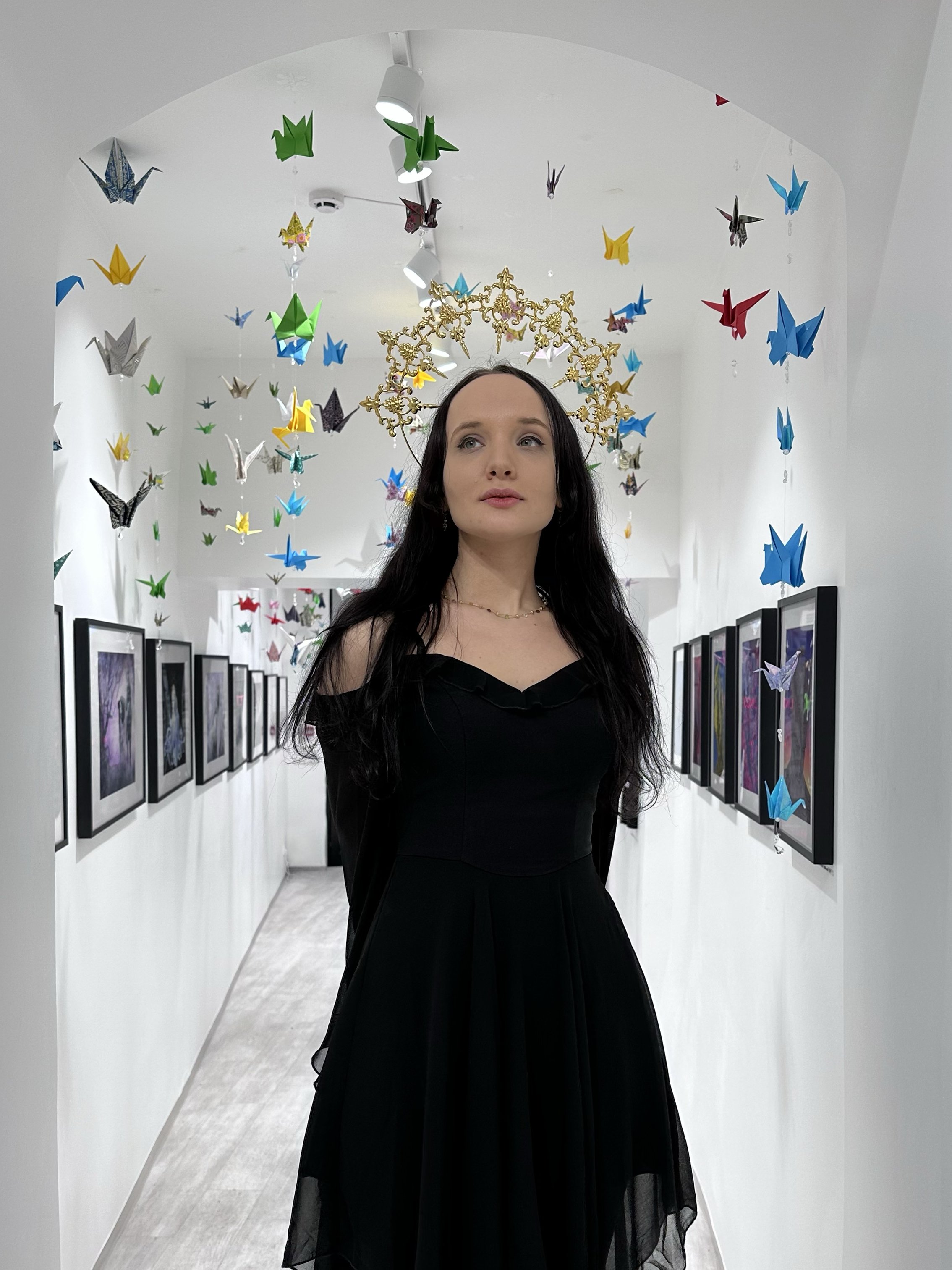
Victoria Olt is a traditional artist whose ethereal paintings fuse classical realism with the dynamic colors of contemporary art. Her work delves into the depths of the human soul, capturing the complex emotions we often try to conceal. Using mixed media, she creates captivating “windows” into inner worlds that feel both timeless and deeply personal. Her art has been exhibited in galleries across the globe and is held in numerous private collections.
Born and raised in Estonia, Victoria later moved to Spain, where she pursued a degree in Fine Arts at the University of Seville. After graduating, she worked as a freelance artist in Madrid and Amsterdam. During the height of the pandemic, she relocated to the secluded island of Nevis, where she completed the Starchild collection. In late 2021, she returned to Estonia to open the Victoria Olt Gallery.








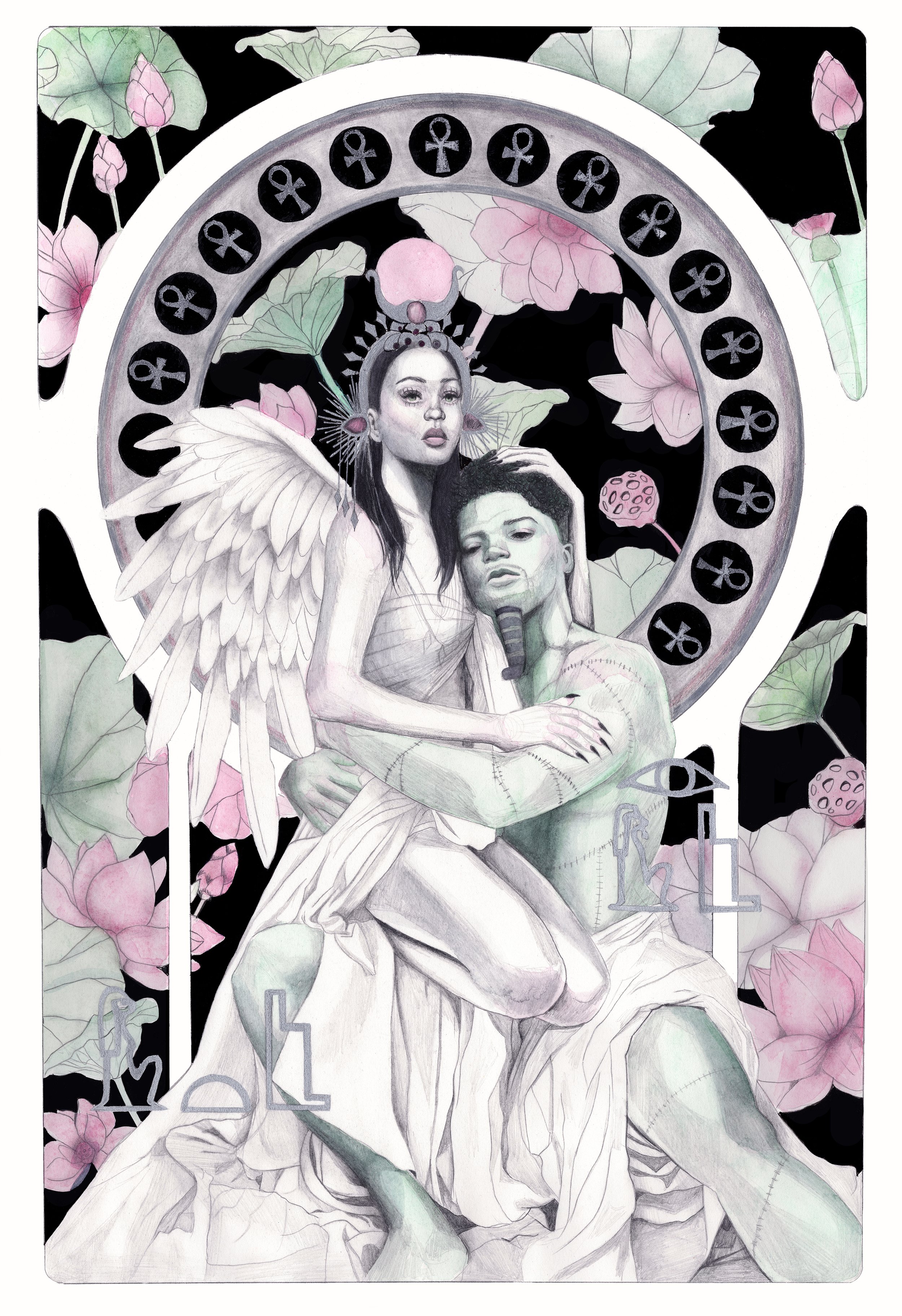
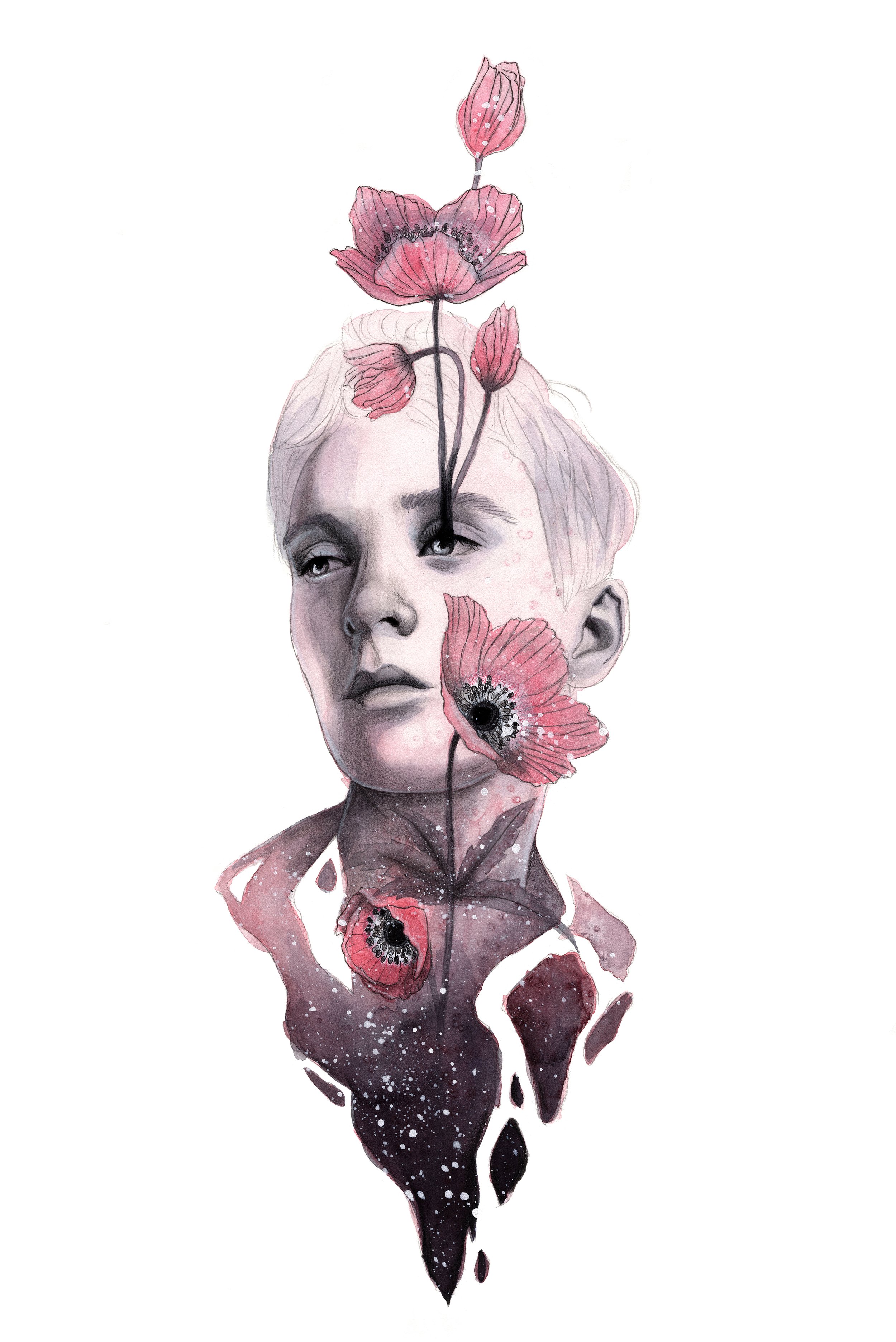

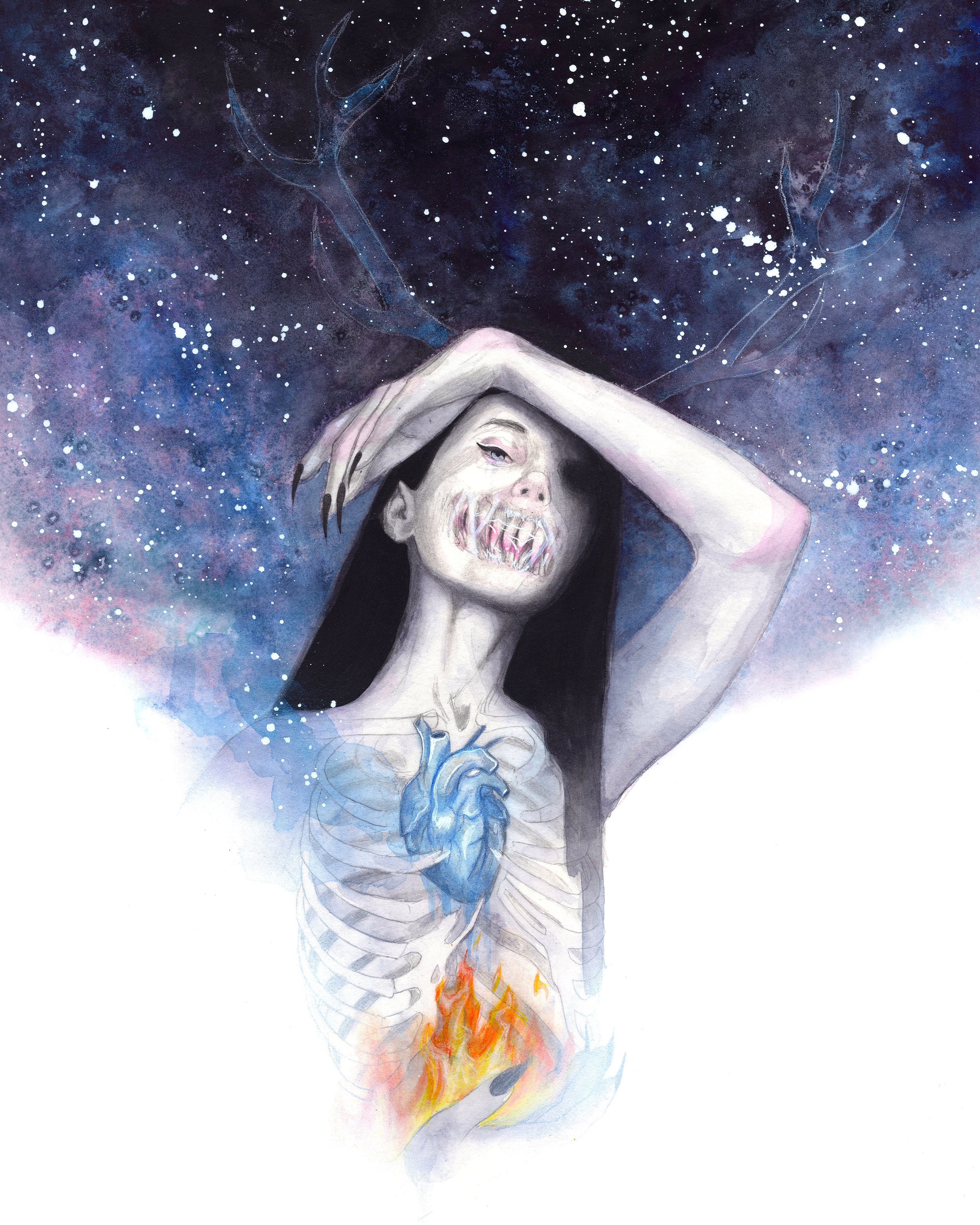
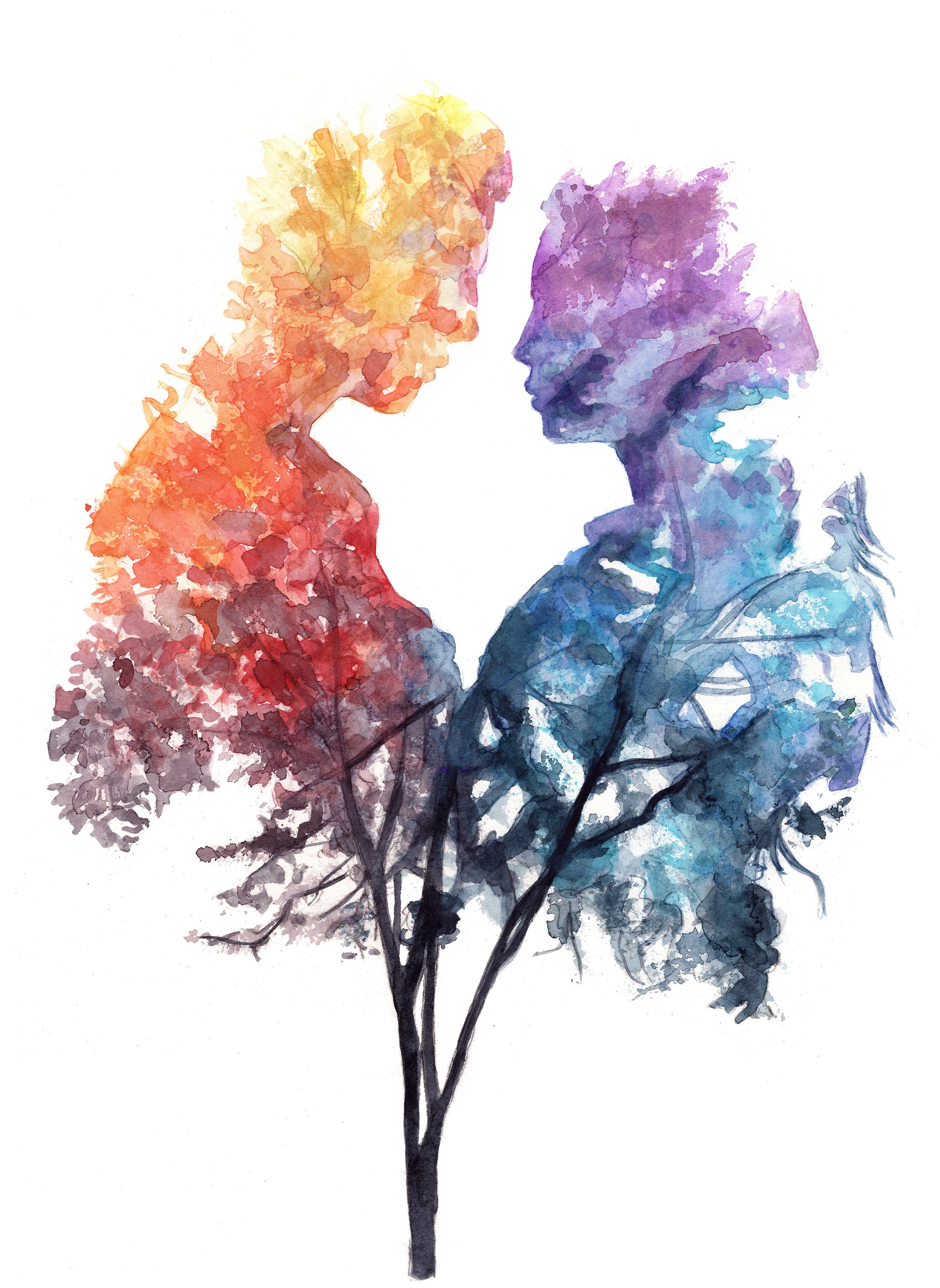











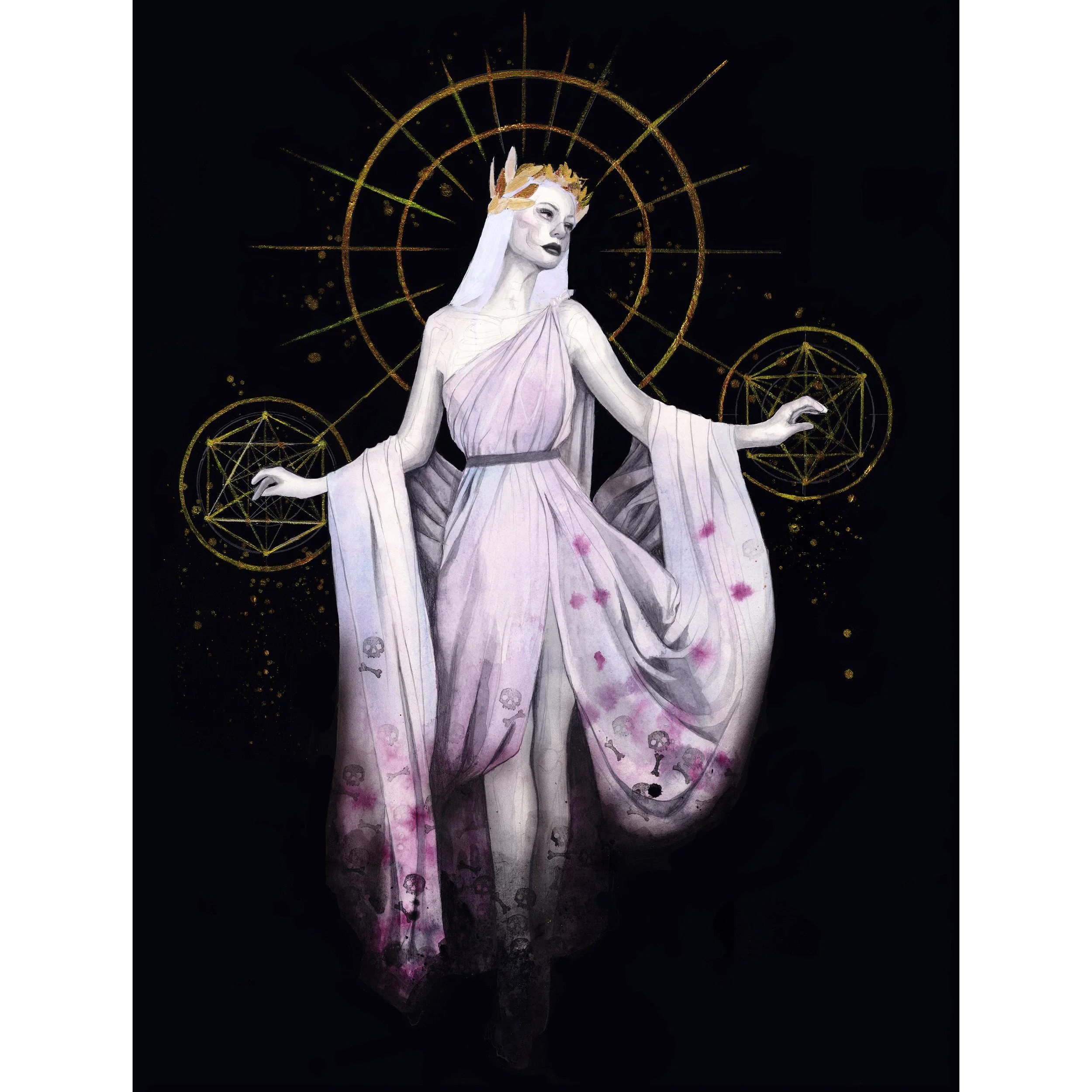




2020
Gouache and handmade watercolor on paper.
18 x 24 in
46 x 61 cm + frame included for free in shipments within Estonia
} Enlil & Ninlil {
The Ancient Sumerian story story starts when Ninlil decides to go to bathe in the river, her mother forbids her to as she doesn’t want her daughter to go alone, but she goes anyway. There she meets the God Enlil, who rapes her. When Ninlil returns home the next morning pregnant, her mother is furious and Enlil is banished to the underworld. But Ninlil misses Enlil and pursues him to the underworld. They make up and decide to stay together and she soon gives birth to Nanna, who is as beautiful as the sun but colder. When she grows up she becomes the goddess of the moon. This story represents the life cycle of crops, from pollination to their withering and eventual return to earth. This story is also considered a coming of age tale.
“The exhibition “Lost Gods” is another step in my quest for meaning, where, after finding no solace in current popular religion, I turn my gaze towards the past, to see what can be learned there. And what I’ve found is that a lot of the issues our ancestors struggled with, are the same issues we have yet to resolve today. We still live at the whim of fate, however you define it. But our ancestors still have fascinating things to say about the human condition, and we would be wise to learn from them.”
-Victoria